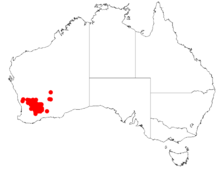| Pukkati | |
|---|---|
| Scientific classification | |
| Kingdom: | Plantae |
| Clade: | Tracheophytes |
| Clade: | Angiosperms |
| Clade: | Eudicots |
| Clade: | Rosids |
| Order: | Fabales |
| Family: | Fabaceae |
| Subfamily: | Caesalpinioideae |
| Clade: | Mimosoid clade |
| Genus: | Acacia |
| Species: | A. beauverdiana |
| Binomial name | |
| Acacia beauverdiana Ewart & Sharman | |

| |
| Acacia beauverdiana occurrence data from Australasian Virtual Herbarium | |
Acacia beauverdiana, commonly known as pukkati, is a member of genus Acacia that is native to Western Australia. It is a perennial tree 1 to 8 metres (3 to 26 ft) tall with multiple stems. It has yellow flowers and it blooms from July to October. It is native to Western Australia.
Aboriginal uses
The Noongar people of southwest Western Australia burned the top small branches of pukkati and mixed the ash with equal parts of pituri (Duboisia hopwoodii) to relieve intense pains such as toothache.
References
- "DOI Details". doi.ala.org.au. doi:10.26197/5c0b1388984eb. Retrieved 8 December 2018.
- "FloraBase the Western Australian Flora". Archived from the original on 6 September 2006. Retrieved 8 April 2007.
- International Legume Database & Information Service (ILDIS)
- Hansen, V.; Horsefall, J. (2016). Noongar Bush Medicine Medicinal plants of the south-west of Western Australia. Crawley, WA: University of Western Australia. p. 129. ISBN 9781742589060.
External links
- Acacia beauverdiana Photo -- Florabase Archived 13 August 2011 at the Wayback Machine
This Acacia-related article is a stub. You can help Misplaced Pages by expanding it. |
This article on a tree of the Fabaceae family is a stub. You can help Misplaced Pages by expanding it. |
This Australian rosid article is a stub. You can help Misplaced Pages by expanding it. |
This Western Australian plant article is a stub. You can help Misplaced Pages by expanding it. |